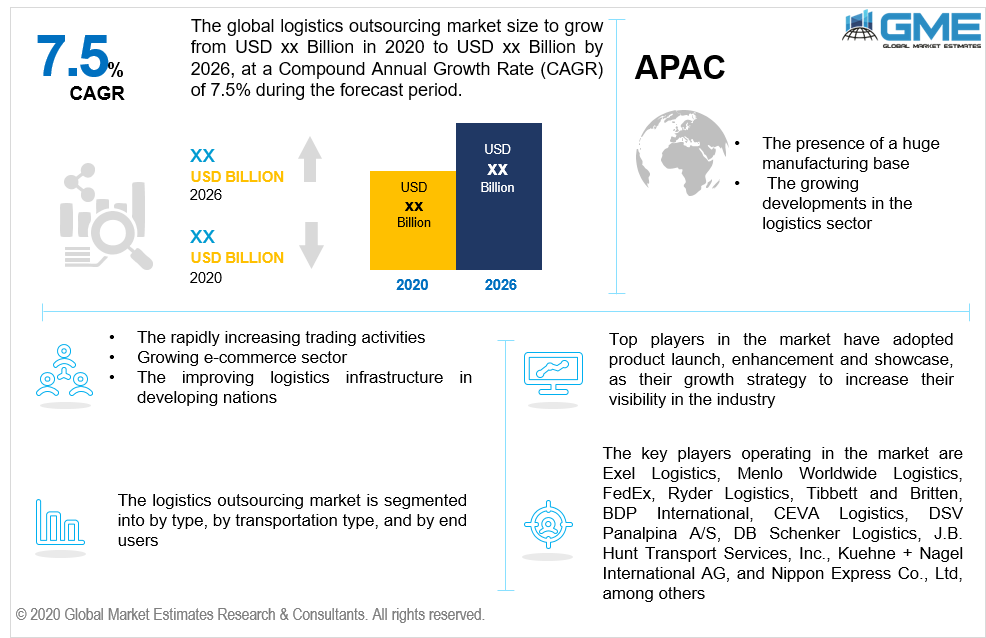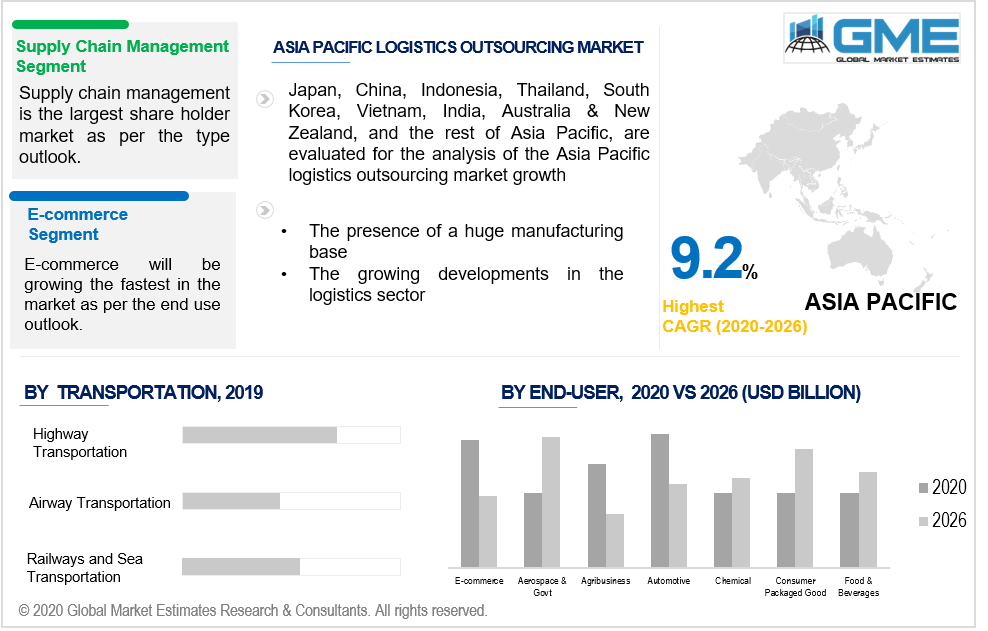
Global Logistics Outsourcing Market Size, Trends, and Analysis - Forecast To 2026 By Type (Material Management, Supply Chain Management, Distribution Management, Shipment Packaging, Channel Management), By Transportation Type (Air Transportation, Sea Transportation, Railway Transportation, Highway Transportation), By End User (E-commerce, Aerospace, and Government, Agribusiness, Automotive, Chemical, Consumer Packaged Good, Food & Beverages, Others), By Region (North America, Asia-Pacific, Middle East & Africa and Europe) End-User Landscape and Company Market Share Analysis and Competitor Analysis
Logistics outsourcing is known as third-party logistics and deals with cross-docking, inventory management, warehousing, and transportation among others. Logistics management includes supply chain management, distribution management, and channel management. The rapidly increasing trading activities along with globalization; the growing e-commerce sector along with increasing international e-commerce activities; and improving logistics infrastructure in developing nations are positively driving the market growth. Logistics outsourcing offers many advantages such as a reduction in indirect costs, improve flexibility, performance improvement, and customer satisfaction among others, and hence will be one of the fastest-growing segments in the automotive and transportation industry.

Based on the type, the logistics outsourcing market is divided into channel management, shipment packaging, material management, distribution management, and supply chain management. The supply chain management segment will hold the largest market share in the global logistics outsourcing market. The growing number of logistics companies along with increasing trade movement of goods are boosting the market growth. The growing retail, healthcare, and e-commerce sectors among developing nations are boosting the segment growth.
By transportation, the global market is segregated into highway transportation, sea transportation, air transportation, and railway transportation. The highway transportation segment will hold a major chunk in the global revenue. The increasing public and private partnerships model along with the increased emphasis on logistics infrastructure are some of the key drivers driving the segment growth.
By end-use vertical, the global market is segregated into e-commerce, aerospace and government, agribusiness, automotive, chemical, consumer packaged goods, and food & beverages, among others. The E-commerce segment will hold a major share in the market. The growing number of online orders along with increasing smart mobiles are boosting the market growth for the e-commerce segment.

The APAC region is predicted to hold a significant market share and expected to grow at a high CAGR between the prediction period. The growing trans-regional trade corridors are driving the market growth in the region. Also, the presence of a huge manufacturing base in the region; the growing developments in the logistics sector, and rapid urbanization are boosting regional growth. The growing demand for third-party logistics among end-use industries in developing and emerging countries, such as Japan, South Korea, and China, are also propelling the growth of the market.
The key players competing in this market are Exel Logistics, Menlo Worldwide Logistics, FedEx, Ryder Logistics, Tibbett and Britten, BDP International, Burris Logistics, C.H. Robinson Worldwide (CHRW) Inc., CEVA Logistics, DSV Panalpina A/S, DB Schenker Logistics, J.B. Hunt Transport Services, Inc., Kuehne + Nagel International AG, Nippon Express Co., Ltd., and XPO Logistics among others.
Please note: This is not an exhaustive list of companies profiled in the report.
We value your investment and offer free customization with every report to fulfil your exact research needs.
The Global Logistics Outsourcing Market has been studied from the year 2019 till 2026. However, the CAGR provided in the report is from the year 2021 to 2026. The research methodology involved three stages: Desk research, Primary research, and Analysis & Output from the entire research process.

The desk research involved a robust background study which meant referring to paid and unpaid databases to understand the market dynamics; mapping contracts from press releases; identifying the key players in the market, studying their product portfolio, competition level, annual reports/SEC filings & investor presentations; and learning the demand and supply side analysis for the Logistics Outsourcing Market.

The primary research activity included telephonic conversations with more than 50 tier 1 industry consultants, distributors, and end-use product manufacturers.

Finally, based on the above thorough research process, an in-depth analysis was carried out considering the following aspects: market attractiveness, current & future market trends, market share analysis, SWOT analysis of the companies and customer analytics.

Tailor made solutions just for you
80% of our clients seek made-to-order reports. How do you want us to tailor yours?
OUR CLIENTS